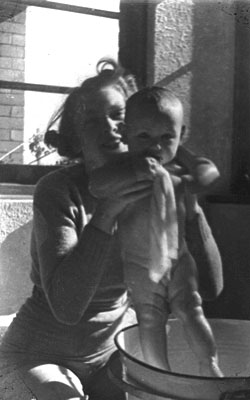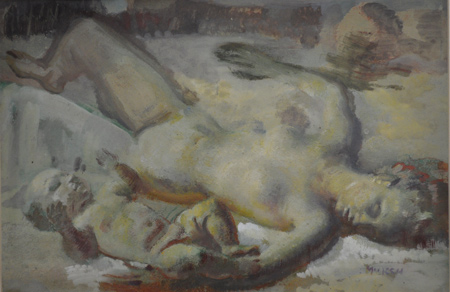Ria Murch recalls meeting Murch backstage at the Theatre Royal and the subsequent events:
September 14 – Arthur and Ria are married.
Leading up to the wedding date, Murch was working on a commission for decorations for the Catholic Church in Cygnet, Tasmania – a stylised sculpted crucified Jesus and 14 paintings of the stations of the Cross. Fellow artist and architect, John D. Moore had designed the church and recommended Arthur for the job.

Crucified Christ, Catholic Church in Cygnet, Tasmania. 1940 Carved wood, paint
Arthur and Ria move to Mona Vale.
November – their son, John, is born.

Ria and John provide inspiration for works such as “Summer Sun” in the National Gallery of Victoria.
A study for Summer Sun is part of the Murch Estate:

Ria Murch describes life during wartime, living in ‘The Mad Half Mile’, Mona Vale:
Murch was recruited to the war effort and served as an official war artist in Darwin. The Australian War Memorial records:
“In April 1942 he was called up by the government to work at Slazenger’s Munitions Annexe at Botany on the design for the butt of the Owen gun. Three months later he was appointed an official war artist. He was paid two guineas per day, had the status of an officer without rank, and all his drawing and painting materials were supplied by the Memorial.”
Read more details of Murch’s engagement as a war artist from the Australian War Memorial site
Murch became ill in Darwin and was returned to Melbourne in January 1943; thence to Sydney where he completed many of the 45 works that are now in the Australian War Memorial.
While living in Newport the Murches became acquainted with the Cotton family. Leo Cotton, father of of Olive Cotton, introduced Arthur to Frank Cotton, Professor of Physiology at Sydney University. Frank was the creator of the anti-gravity pressure suit which was a breakthrough for altitude flying for WWII pilots. The work led to the pressure suits used in US space exploration. Murch was called in to help with the process of plaster casting, moulding and production of the rubber suit. There are pieces of the original “Cotton Flying Suit” in the the University of Sydney Museum collections.
Ria, Arthur and John lived in the creative hub known as “The Mad Half Mile” (Waterview Street, Mona Vale). Fellow artists in the neighbourhood were Weaver Hawkins and Raymond Glass. Murch exhibited at:
The Macquarie Galleries (Bligh Street, Sydney) in June 1944. Key works: The Squirrel and The Flea
Canberra Hotel, Brisbane in June 1945. Key work: The Foundry
Murch taught sculpture, three days a week at East Sydney Technical College after his return from Darwin. Along with Bill Dobell and Jimmy Cook, Murch taught for the CRTS – the Commonwealth Reconstruction Training Scheme, providing training for returned servicemen and women.
Ria and Arthur purchased Block 394 Palmgrove Road Avalon Beach for £300. There was a partially built home but no water, kitchen or bathroom. John Murch recalls a very “pioneery” atmosphere – kero lamps and outdoor cooking. Murch built the house while undertaking sculpture work. A long and strong friendship with Colin Brown began when he came to live and help with the sculpture projects which included a commissioned Christ the King for a school. Colin fished and caught rabbits to help keep everyone fed. Another religious sculpture project was the St Clare and St Francis, commissioned via John Moore, for the St Francis of Assisi Church in Paddington.
Murch won the Archibald Prize in in 1949 with the portrait of Bonar Dunlop who had been a student in Murch’s CRTS sculpture class. The prize was £5oo.
View the Cinesound Newsreel of the 1949 Archibald Prize.
1902 - 19191920 - 19281929 - 19391940 - 1949